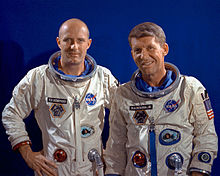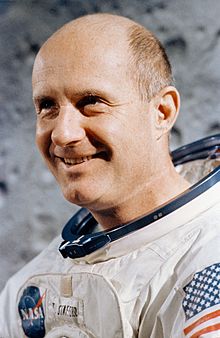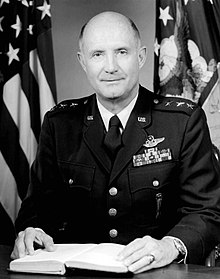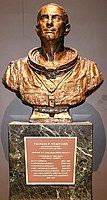Thomas P. Stafford
Thomas P. Stafford | |
|---|---|
NASA astronaut | |
| Rank | Lieutenant General, USAF |
Time in space | 21d 3h 42m |
| Selection | NASA Group 2 (1962) |
| Missions | |
Mission insignia | |
| Retirement | November 1, 1979 |
Thomas Patten Stafford (September 17, 1930 – March 18, 2024) was an American
After graduating from the
In 1975, Stafford was the commander of the Apollo-Soyuz Test Project (ASTP) flight, the first joint U.S.-Soviet space mission. A brigadier general at the time, he became the first general officer to fly in space. He was the first member of his Naval Academy class to pin on the first, second, and third stars of a general officer. He made six rendezvous in space and logged 507 hours of space flight.
Stafford flew more than 120 types of fixed-wing and
In 1993, the Stafford Air & Space Museum was founded in his hometown of Weatherford, Oklahoma. Originally just two rooms, it has grown to over 63,000 square feet (5,850 m2) of artifact space. It is a Smithsonian affiliate and is the only museum in the world to house test-fired engines that would have been used in the Space Race: a U.S. F-1 engine and a Soviet NK-33 engine. It holds the Gemini 6 spacecraft that he and Schirra flew in a rendezvous with Gemini 7.
Early life and education
Thomas Patten Stafford was born on September 17, 1930, in
In his senior year of high school, Stafford was recruited to play football at the
Military service
In high school, Stafford served in the 45th Infantry Division in the Oklahoma National Guard. Soon after, he transferred to the division's 158th Field Artillery Battalion, where he plotted targets for artillery fires.[1]: 6 [3]
Stafford attended the first phase of pilot training at
In 1958, Stafford attended the Air Force Test Pilot School at
NASA career
In April 1962, while working as a flight instructor, Stafford applied for the next round of astronaut selection. The required interviews and medical screenings occurred over the summer of 1962 at
Project Gemini
Gemini 6A

Stafford was originally scheduled to fly with Alan Shepard on the first crewed Gemini mission, Gemini 3, but was replaced when Shepard was removed from the flight rotation after being diagnosed with Ménière's disease. Stafford was paired with Wally Schirra as pilot and commander, respectively, and the pair was reassigned as the backup crew for Gemini 3, and primary crew for Gemini 6.[1]: 50
The original Gemini 6 mission profile involved docking with an Agena target vehicle. On October 25, 1965, Schirra and Stafford were inside Gemini 6 before liftoff when the Agena vehicle exploded on ascent. After the original mission was canceled, it was redesignated Gemini 6A and was planned to rendezvous with the long-duration Gemini 7 mission. Gemini 7 lifted off on December 4, 1965. On December 12, 1965, Gemini 6A's ignition was followed by an immediate engine shutdown. Schirra and Stafford did not eject, and the cause of the shutdown was found to be an electrical issue and a cap inadvertently left on a fuel line.[1]: 64–72
On December 15, 1965, Gemini 6A lifted off and rendezvoused with Gemini 7. The two spacecraft kept station for about five hours, coming within feet of each other. Gemini 6A splashed down on December 16, and was recovered by USS Wasp.[1]: 70–76
Gemini 9A
Before Gemini 6A, Stafford was assigned as the backup commander for Gemini 9 with
On May 17, 1966, the Agena target vehicle went off course and was shut down before entering orbit. As there was no replacement Agena rocket, the new target for the mission was the
The following day, Cernan attempted an extravehicular activity (EVA), with the primary mission of testing the Astronaut Maneuvering Unit (AMU). After exiting the spacecraft, Cernan quickly experienced mobility issues, followed by environmental regulation and communication issues. The EVA was aborted, and Cernan returned to the capsule after two hours. On June 6, Gemini 9A landed, and was recovered by USS Wasp.[1]: 92–95
Apollo program

After Gemini 9A, Stafford was assigned as the backup command module pilot on what was then planned as Apollo 2, with Frank Borman as the commander and Mike Collins as the lunar module pilot. For his technical assignment, Stafford was tasked as an astronaut liaison for the development of Apollo guidance and navigation systems, as well as the command and service module. In late 1966, he was reassigned to Apollo 2 backup commander, with Apollo 10 crewmates John Young as the command module pilot and Gene Cernan as the lunar module pilot. While testing the command module, they received word of the Apollo 1 fire and subsequent suspension of the Apollo program.[1]: 95–105 [6]: 1–6
Apollo 10
In the spring of 1968, Deke Slayton announced that the previous backup crew for Apollo 2 would become the primary crew for Apollo 10. In preparation for the mission, Stafford helped design a color camera to replace the grainy black-and-white video broadcast before from space; he felt that public outreach was a vital aspect of the mission.
Apollo 10 lifted off on May 18, 1969. Despite heavy oscillation during ascent, Apollo 10 achieved orbit without incident, docked the LM and CM, and achieved its translunar injection burn. Upon arriving in lunar orbit, Stafford and Cernan undocked in the LM and entered an elliptical orbit with a periapsis (the closest distance) of nine miles over the lunar surface. To provide reconnaissance, the periapsis coincided with the Sea of Tranquility, the intended landing site for Apollo 11. Upon ascent, the LM began turning rapidly from a misaligned switch on the Abort Guidance System; Stafford was able to regain control and conduct the burn to rendezvous with the CM. The LM docked with the CM to return the astronauts and was jettisoned. After two days in lunar orbit, Apollo 10 began its return trajectory. Along the return, the capsule traveled at 24,791 mph (39,897 km/h), setting the record for the fastest speed by a human being. Apollo 10 splashed down east of Samoa and was recovered by USS Princeton.[1]: 120–135
Apollo-Soyuz Test Project

In July 1969, Stafford replaced Alan Shepard (who had returned to flight status) as
Beginning in 1973, the ASTP team trained extensively in Russia and the United States.
Post-NASA career

In June 1975, before ASTP, Stafford was offered command of the
With no statement of need or requirements, Stafford pushed for and started a larger attack stealth aircraft named
In early 1979, before giving a speech at the Chicago chapter of the Air Force Association, Stafford met with the Chairman of
Following his retirement, Stafford served on several corporate boards, including
In 2002, Stafford published an autobiography written with Michael Cassutt, titled We Have Capture: Tom Stafford and the Space Race.[1] He also wrote the epilogue of the 2011 book Falling to Earth: An Apollo 15 Astronaut's Journey to the Moon by fellow Apollo astronaut Al Worden.[13]
Stafford and Soviet commander Alexey Leonov, became lasting friends, with Leonov being the godfather of Stafford's younger children.[14][15] Stafford gave a eulogy in Russian at Leonov's funeral in October 2019.[16][17]
Personal life and death
In 1953, Stafford married Faye Shoemaker from Weatherford, Oklahoma. Faye and Stafford had two daughters, Dionne (born 1954) and Karin (born 1957). Faye and Stafford divorced in 1985. Stafford later married Linda Ann Dishman in December 1988.
Stafford died from liver cancer at a care home in Satellite Beach, Florida, on March 18, 2024, at the age of 93.[18][19]
Awards and honors
This is the greatest honor of my life. I am very proud to have contributed to our nation's future in space and I am deeply grateful for the opportunity to have participated in the beginning of America's venture into the new and endless frontier.
— Upon receiving the Congressional Space Medal of Honor.[20]
Throughout his career, Stafford received numerous awards for his accomplishments. He was a recipient of the
Stafford's military decorations and awards include: the
In 2011, Stafford was awarded the National Aeronautic Association Wright Brothers Memorial Trophy, and the Air Force Association's Lifetime Achievement Award. He was elected to the National Academy of Engineering in 2014.
Honoraria: Stafford was the recipient of a
In his hometown of Weatherford, Stafford was honored with a building at Southwestern Oklahoma State University named in his honor, the Thomas P. Stafford Airport, and the Stafford Air & Space Museum.[34][35][36] The Stafford Building at the Federal Aviation Administration (FAA) Mike Monroney Aeronautical Center in Oklahoma City is named after him.[37] In September 2018, Stafford was depicted in a corn maze in Hydro, Oklahoma.[38]
-
Stafford was presented with theMoscow Kremlin
-
Bust of Stafford at the USAF Museum
In media
- 1974 TV movie Houston, We've Got a Problem – played by himself[39]
- 1990 album rock band New Model Army – quotes Stafford in the song "Space"[40]
- 1996 TV movie Apollo 11 – was played by Tony Carlin.[41]
- 1998 HBO miniseries From the Earth to the Moon – played by Steve Hofvendahl.[42]
- 2013 Pilot episode of The Americans on FX, played by an uncredited actor[43]
See also
Notes
- ^ The U.S. Air Force Academy was not yet established at this time.
References
- ^ ISBN 978-1-58834-070-2.
- ^ a b "Lieutenant General Thomas P. Stafford". United States Air Force. February 1979. Archived from the original on February 8, 2018. Retrieved February 7, 2018.
- ^ "158th Field Artillery Regiment | Lineage and Honors | U.S. Army Center of Military History (CMH)". Archived from the original on July 25, 2021. Retrieved February 26, 2021.
- ^ a b c d e f g h "THOMAS P. STAFFORD, LIEUTENANT GENERAL, U.S. AIR FORCE (RET.), NASA ASTRONAUT (FORMER)" (PDF). NASA. March 2014. Archived (PDF) from the original on July 7, 2021. Retrieved June 18, 2021.
- ^ "Here are the Next Nine Astronauts Who Will Join in U.S. Race to the Moon". The Tampa Tribune. Tampa, Florida. UPI. September 18, 1962. p. 4. Archived from the original on June 29, 2019. Retrieved June 29, 2019 – via Newspapers.com.
- ISBN 978-0-312-19906-7. Archivedfrom the original on March 23, 2024. Retrieved October 20, 2020.
- ^ Lebar, Stanley (Summer 1997). "The Color War goes to the Moon" (PDF). Invention and Technology. Archived (PDF) from the original on December 21, 2016. Retrieved February 7, 2018.
- ^ "F-117 Nighthawk". Lockheed Martin. Archived from the original on March 19, 2024. Retrieved March 19, 2024.
- ^ "1,000+ Stealth Aircraft - Now That's a Milestone". Lockheed Martin. Archived from the original on March 19, 2024. Retrieved March 19, 2024.
- ^ "Nighthawks Over Iraq: A Chronology of the F-117A Stealth Fighter in Operations Desert Shield and Desert Storm" (PDF). George Washington University. Archived (PDF) from the original on March 29, 2020. Retrieved March 19, 2024.
- ^ "America's Airman: David Deptula and the Airpower Moment" (PDF). Defense Technical Information Center. Archived (PDF) from the original on March 23, 2024. Retrieved March 19, 2024.
- ^ "America at the Threshold" (PDF). USRA. May 3, 1991. Archived (PDF) from the original on January 18, 2023. Retrieved December 21, 2022.
- ^ Worden, Alfred (2017). "Falling to Earth – The Autobiography of Alfred Worden". Alfred Worden. Archived from the original on May 1, 2019. Retrieved January 22, 2018.
- ^ Kellie Morgan (July 15, 2015). "How historic handshake in space brought superpowers closer". CNN. Archived from the original on June 14, 2018. Retrieved June 13, 2018.
- ^ "Apollo–Soyuz: A cold war handshake in space, 40 years on". New Scientist. July 17, 2015. Archived from the original on June 14, 2018. Retrieved June 13, 2018.
- ^ "Russia bids farewell to first man who walked in space". MSN. October 15, 2019. Archived from the original on November 1, 2019. Retrieved February 17, 2021.
- ^ "Russia buries cosmonaut Alexei Leonov, first human to walk in space". Reuters. October 15, 2019. Archived from the original on April 21, 2022. Retrieved January 17, 2023.
- collectSpace. Archivedfrom the original on March 18, 2024. Retrieved March 18, 2024.
- ^ Goldstein, Richard (March 18, 2024). "Thomas Stafford, 93, Commander of First U.S.-Soviet Space Mission, Dies". The New York Times. Archived from the original on March 18, 2024. Retrieved March 18, 2024.
- ^ International Space Hall of Fame at New Mexico Museum of Space History. 2018. Archivedfrom the original on April 30, 2020. Retrieved January 22, 2018.
- ^ "The Elmer A. Sperry Award". Elmer A. Sperry Board of Award. May 18, 2009. Archived from the original on September 28, 2007. Retrieved January 22, 2018.
- ^ "4 Gemini Astronauts Agree Man Can Survive in Space". The Tampa Tribune. Tampa, Florida. December 31, 1965. p. 3-B. Archived from the original on February 4, 2022. Retrieved November 28, 2019 – via Newspapers.com.
- American Academy of Achievement. Archivedfrom the original on December 15, 2016. Retrieved May 22, 2020.
- ^ "The Gen. Thomas D. White USAF Space Trophy" (PDF). AIR FORCE Magazine. USAF. May 1997. p. 156. Archived (PDF) from the original on March 6, 2022.
- ^ "Edwards Commander Awarded Medals". The Bakersfield Californian. Bakersfield, California. October 1, 1976. p. 9. Archived from the original on April 30, 2019. Retrieved April 12, 2019 – via Newspapers.com.
- ^ "State Aviation Hall of Fame Inducts 9". The Daily Oklahoman. Oklahoma City, Oklahoma. December 19, 1980. p. 2S. Archived from the original on March 27, 2019. Retrieved February 11, 2019 – via Newspapers.com.
- ^ "Thomas Stafford". Astronaut Scholarship Foundation. 2013. Archived from the original on December 14, 2017. Retrieved January 22, 2018.
- ^ Clark, Amy (March 14, 1993). "Activities Honor Gemini Astronauts". Florida Today. Cocoa, Florida. p. 41. Archived from the original on July 6, 2019. Retrieved July 6, 2019 – via Newspapers.com.
- ^ McClellan, Doug (October 5, 1980). "Space Hall of Fame Honors Four". El Paso Times. El Paso, Texas. p. 1B. Archived from the original on February 12, 2019. Retrieved February 10, 2019 – via Newspapers.com.
- ISBN 978-1-57864-397-4.
- ^ "AAS Fellows". American Astronautical Society. 2018. Archived from the original on January 31, 2018. Retrieved January 16, 2018.
- Oklahoma State University. Archivedfrom the original on April 14, 2019. Retrieved January 16, 2018.
- ^ "General James E. Hill Lifetime Space Achievement Award". Space Foundation. 2020. Archived from the original on October 19, 2020. Retrieved October 19, 2020.
- ^ "Oklahoma Airports". Federal Aviation Administration. 2018. Archived from the original on January 23, 2018. Retrieved January 22, 2018.
- ^ "Stafford Air & Space Museum". Stafford Air & Space Museum. 2018. Archived from the original on January 8, 2018. Retrieved January 22, 2018.
- ^ "Gen. Thomas P. Stafford at SWOSU". Southwestern Oklahoma State University. 2018. Archived from the original on January 24, 2018. Retrieved January 22, 2018.
- ^ Johnson, James (July 1, 1989). "Astronaut Dedicates FAA Center". News OK. Retrieved January 21, 2018.
- ^ "Oklahoma corn maze honoring former astronaut is visible from space". Associated Press. September 24, 2018. Archived from the original on September 24, 2018. Retrieved September 25, 2018.
- Internet Movie Database. 2018. Archivedfrom the original on April 21, 2022. Retrieved January 16, 2018.
- ^ Sullivan, Justin; Morrow, Stuart; Tompkins, Phil (2018). "Space". New Model Army. Archived from the original on January 17, 2018. Retrieved January 16, 2018.
- Internet Movie Database. 2018. Archivedfrom the original on April 21, 2022. Retrieved January 16, 2018.
- Internet Movie Database. 2018. Archivedfrom the original on February 19, 2017. Retrieved January 16, 2018.
- Vulture.com. Archivedfrom the original on March 25, 2018. Retrieved March 27, 2018.
External links
- "THOMAS P. STAFFORD, LIEUTENANT GENERAL, U.S. AIR FORCE (RET.), NASA ASTRONAUT (FORMER)" (PDF). NASA. March 2014. Retrieved June 18, 2021.
- Lieutenant General Thomas P. Stafford United States Air Force biography
- Appearances on C-SPAN
- Thomas P. Stafford at IMDb
- Thomas P. Stafford discography at Discogs



